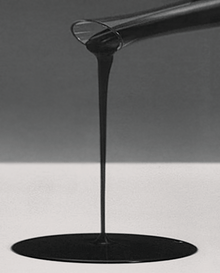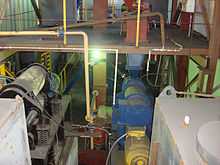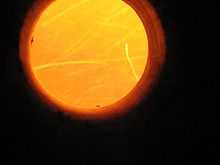Coal-water slurry fuel
Coal-water slurry fuel (CWSF or CWS or CWF) is a fuel consisting of fine coal particles suspended in water. Presence of water in CWSF reduces harmful emissions into the atmosphere, makes the coal explosion-proof, makes use of a coal equivalent to liquid fuel (e.g. heating oil), and gives other benefits (see below).
CWSH is 55-70% fine dispersed coal particles and 30-45% water. Coal particles suitable for diesel fuel replacement typically need to be less than 20 micrometres in diameter.
General characteristics
A coal-water slurry is defined by its rheological (viscosity, bias voltage), sedimentation (retention uniformity in static and dynamic conditions) and fuel (energy potential, full burning of the organic compounds) characteristics. The parameters of coal-water slurry fuel are clearly defined by national China standards[1] that can be used as the worldwide standard. Also, the coal-water slurry fuel is characterized by the following properties: ignition temperature — 800—850 °С, combustion temperature — 950—1150 ° С, calorific value — 3700—4700 kcal/kg. The level of carbon combustion is greater than 99%. The coal-water slurry fuel is fire- and explosion-proof.

| Parameters | І GRADE | ІІ GRADE | ІІІ GRADE | China standard |
|---|---|---|---|---|
| Coal content, % | ≥65 | 63~65 | 60~63 | GB/T18856.2 |
| Viscosity | ≤ 1200 | GB/T18856.4 | ||
| Minimum energy yield, kcal/kg | ≥ 4700 | 4420 — 4660 | 4000 — 4420 | GB/T 213 |
| Ash content, % | ≤ 6 | 6~8 | 8~10 | GB/T 213 |
| Sulfur content, % | ≤ 0.35 | 0.35~0.65 | 0.65~0.80 | GB/T 214 |
| Ash softening temperature | ≤ 1250 | GB/T 219 | ||
| Particles of more than 300 µm, % | ≤ 0.05 | 0.05~0.20 | 0,20~0,80 | GB/T18856.3 |
| Particles up to 75 µm, % | ≥75.0 | |||
| Volatile content, % | >30 | 20~30 | ≤ 20 | GB/T18856.7 |
Uses
CWS can be used in place of oil and gas in any size of heating and power station. CWS is suitable for existing gas, oil, and coal fired boilers. During the last 30 years the US Department Of Energy (DOE) has been researching the use of coal/water fuels in boilers, gas turbines and diesel engines. When used in low speed diesels CWF provides a thermal efficiency rating that rivals combined cycle gas turbines that burn natural gas as their primary fuel. It has been suggested that modified modular diesel engined electric power plants burning CWF are economically competitive with natural gas fired peaking electric plants in the 10 MWe to 100 MWe range of power supply.
Benefits
The presence of water in CWS reduces harmful emissions into the atmosphere and makes the coal explosion-proof. By converting the coal into a liquid form, delivery and dispensing of the fuel can be simplified.
Because of the low cost of coal when compared to other energy sources, CWS is a competitive alternative to oil and natural gas. Depending on geographical area the price per unit energy of CWS may be 30% to 70% lower than the equivalent amount of oil or gas.
Low cost per BTU make CWS a cost effective fuel for heat and electric power generation.
One side benefit of the coal water slurry production process is the separation of the non carbonaceous material that is part of the coal before treatment. This results in a reduction of ash content to as little as 2% for coal water slurry fuel, which can make it a viable alternative to diesel fuel #2 in large stationary engines or diesel electric locomotives.
History
Toward the end of the 1950s, the Soviet Union started the development of new ways to utilize coal sludge for power generation. Two major problems of sludge transportation and sludge combustion were solved during the series of experiments and research.
Ball mills pulverize and mix the coal sludge with water producing coal-water slurry (mix of liquids and hard particles). CWS produced by milling the sludge and/or regular coal near the coal mine near Belovo (Siberia, Russia) was transported through the pipeline to Novosibirsk (Siberia, Russia), a distance of 262 km. Three intermediate pump-stations were installed for pumping CWS to Novosibirskaya TEC-5 in Novosibirsk.
The unique difference of project Belovo-Novosibirsk[2] uses CWS directly for combustion in steam boilers at a rate of 1340 t per hour. In other world projects CWS was used only for transportation which was followed then with drying of CWS before the combustion of the pulverized coal.
A project at Belovo-Novosibirsk was started in 1989 but delayed and finished in 1993 due to economic disruptions caused by the transition from the Soviet Union to Russia. A drop in oil and gas prices made the use of CWS coal combustion less economic.
Since 2004, Russia has continued the development and implementation of CWS technology for heating stations (for district heating) and power stations.[3][4]
- Ukraine
Significant volumes of natural gas import, its high price and the extremely low level of payments for used fuel by municipal consumers lead to significant expenses of budgetary funds for refund of the difference in tariffs and subsidies in the form of supplying the natural gas at a lower price. The Government of Ukraine established several directives for the fuel and energy industry. These initiatives include:
- Agreement assigning the list of actions for the implementation of resource-and energy-saving technologies,
- Verkhovna Rada of Ukraine has involve China Development Bank credit for the implementation of coal-water slurry fuel technology and coal gasification projects . Total amount $ 3.6 billion.
- The order of President of Ukraine to establish a working group on the transferring of natural gas to coal produced domestically
In Ukraine, there are objects where coal-water slurry technology was successfully implemented. It is known that the «Ukrainian heat» company has implemented the project based on the Modified Chinese technology taking into account the Ukrainian coal.
CWS fuel technology is implemented in Ukraine by the State Enterprise "Ukteplokom" as a part of the national project «Energy of Nature».
Company supported by the Agency of Investment and National Projects of Ukraine is implementing a project of transferring boiler plants from natural gas to CWS fuel. The planned capacity of the modified hot-water boilers is 2500 Gcal per year, which will reduce the natural gas consumption by 2.5 billion m3. On the first stage, during the pilot project will be refitted boiler plants and built plants on CWS preparation in three cities.
Performed Ukrainian research technology[5]
- Russia
Since 2004, the development of technology in Russia got a new turn. Since the Belovo-Novosibirsk project was closed, the first experimental industrial center of CWS preparation was built in the Enskiy village Murmansk region. The workshop of CWS preparation in the Enskiy village[6] uses the previous generation technology (vibrating mills) for wet grinding of coal and CWS preparation.
Technology
Preparation of CWS

CWS preparation consists of three major stages:
- Prior crushing to 10 to 25 micrometers or 60 to 65 micrometers
- Wet milling and homogenization
- Intermediate storage
Standard crushers can be used for prior crushing of raw coal. During the wet milling and homogenization stage, coal is milled and mixed with water and (if required) some additives. The Amalthea[7] group of companies (Russia) has developed a highly efficient, low energy consumption, method of wet milling and homogenization that reduces energy expenditure for the production of each ton of CWS and avoids using additives to make the coal slurry stable.
Raw material for CWS preparation
Coal of almost any type can be used as a raw material for CWS. This includes lignite (brown coal) flame and gas flame coals and anthracite. Coal waste slurries can also be used for preparing CWS.
- Desirable ash content
- Less than 10% if using in gas/oil boilers
- No limit if using in coal boilers
- Development
| Type of coal | Possibility |
|---|---|
| Brown coals (lignites) | possible, tested and confirmed |
| Flame coal (V=40…45%) | well developed[8] |
| Gas flame coal, gas coal (V=28…40%) | well developed |
| Fat coal – anthracite (V=7…28%) | possible, tested and confirmed |
Combustion of CWS

CWF can be used in several different applications. In the largest particle form it is a viable substitute for heavy grade fuel oils used to produce steam in boilers such as Diesel #6, Bunker C and Bunker D residual oil fuels. Additionally when the particle size is 80 micrometres or less the CWF can be used as a cofuel or substitute fuel in diesel engines. Low speed marine or modular powerplant diesels can operate on pure CWF. Medium speed diesels such as locomotive engines sometimes need a co-injection of Diesel #2 which acts as an ignition source for the CWF. For gas turbine testing CWF particles five to ten micrometres in size have been used to demonstrate useful substitution for petroleum or natural gas in combined cycle gas turbine powerplant applications. The smaller the particle size, the more versatile the CWF is for application. However, the finer the particle size, the more difficult it is to manufacture.
See also
References
- ↑ http://www.docin.com/p-54578543.html[]
- ↑ http://vodougol.ru/en/belovo-novosibirsk
- ↑ http://vodougol.ru
- ↑ "ЖИДКИЙ УГОЛЬ | Блог о Водоугольном Топливе". Liquidcoal.ru. Retrieved 2013-03-30.
- ↑ |V. Biletsky, P. Sergeyev, O. Krut. FUNDAMENTALS OF HIGHLY LOADED COAL-WATER SLURRIES . Mining of Mineral Deposits // CRC Press Taylor & Francis Group, London, UK. A Balkema Book. 2013. – P. 105-114.
- ↑ Водоугольное топливо в пос. Ёнский
- ↑ http://www.vodougol.ru
- ↑ Production of CWS, video